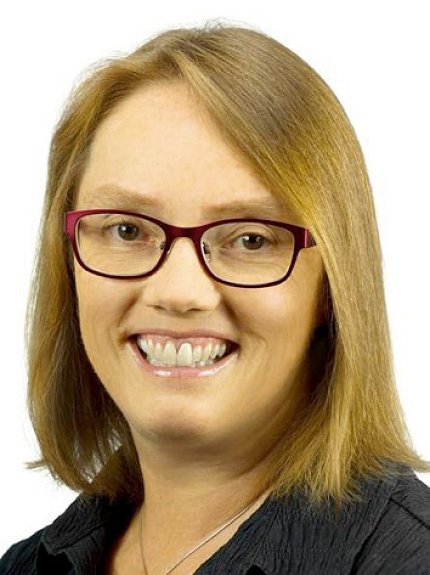Painless GWAS
Attractions of Commercial Genome Testing

If you haven’t been to the drug store lately, it may come as a surprise to find, there on the shelves as you search for toothpaste, deodorant and a greeting card, little boxes inviting you to spit in a tube and find out about your genetic past.
A representative of one of those companies—23andMe—visited NIH recently to explain what these kits are all about.
Dr. Joanna Mountain is senior director of research at 23andMe, a Silicon Valley company now in its 10th year, and a self-described latecomer to the scientific life. She was already in her mid-20s and finished with 2 years of Peace Corps service in Kenya when lab life beckoned. She gave up a faculty position at Stanford to join a company that is fundamentally about research.
About 5 million people, and more every month, have—out of curiosity about whether they are at risk of Alzheimer’s disease, prone to motion sickness or perhaps really descended from Irish royalty—purchased the 23andMe kit.
Buyers provide a saliva sample and mail it to the company. Within 2-4 weeks, they get details on their risk of dozens of conditions, ancestry information and hints about dozens of traits, Mountain said.
“Something in there will be novel and interesting and engaging,” she said. “Some people actually discover new relatives they didn’t know about before. It’s happening quite often.”
How people self-identify doesn’t always correlate with their genetic ancestry, she added.
Although participants can sign up for as many studies as they wish, enrollees typically receive 7 reports on their genetic health risk, more than 40 reports on their genetic carrier status, more than 5 ancestry reports, 8 wellness reports and information on more than 20 traits, Mountain said.
The company uses sequencing arrays from Illumina and scans only a half-million or so positions on the genome that are known to be informative. Whole-genome sequencing is currently too expensive, Mountain said, but 23andMe is “keeping an eye on cost, and accuracy. We haven’t made that leap yet.”
Many kit buyers are worried about specific health risks. “So many people asked for information on Alzheimer’s disease,” said Mountain. “They worry about a higher than average risk. We have no reports yet on early-onset genes. But an important part of our service is the education we can provide. We encourage our customers to be skeptical and thoughtful.”
Also of great public interest is one’s proportion of ancestry from different parts of the world, Mountain noted.
Customers of 23andMe can participate in as many surveys as they want—about 80 percent consent to be part of a research program overseen by an institutional review board—and are free to cease participation at any time. Mountain herself is in at least 60 genome-wide association studies (GWAS), including one on myopia. More than 20 genetic variants have been associated with myopia so far, she said, “mostly genes linked to the visual cycle.”
The average 23andMe customer is age 49, and 50.6 percent are female. More than 75 percent are of European ancestry, with 9 percent Latino, 4 percent East Asian, 4 percent African American and 6 percent “other.”
“Our customers tend to trust us,” said Mountain. “We’re conservative with our data. Participation is easy, geography is no barrier and almost everyone is in multiple studies.” There’s even a smartphone app.
Hoping to draw on the big-data power of large cohorts, 23andMe embarked in March 2009 on its first focus initiative, on Parkinson’s disease. More than 711,000 people are currently enrolled in that GWAS effort. There are also initiatives in irritable bowel syndrome, lupus, fertility and bipolar/major depressive disorder, Mountain reported. Genetic data, she explained, is likely to be a boon for drug development.
New initiatives are planned for wellness research and weight-loss research. “We’re looking for hundreds of thousands of people,” she said. Researchers want to know, for example, if it is genetically easier for some people to lose weight.
Some 100 research papers have been published so far using 23andMe data, Mountain said. Her company hires science writers to craft blog posts that explain these papers in plain language that customers can understand.
Her company is looking to expand the diversity of its data sets, Mountain said, especially from under-represented populations around the world.
In February, 23andMe launched its Global Genetics Project, which is targeting 60 countries and hoping to attract at least 400 people from each.
Mountain said the rewards of research participation are many. “People get direct rewards and are also part of a ‘virtuous cycle.’ We publish all our results in open-access journals.”
Enrollees can push a button on their accounts page and find out how many papers their data has contributed to, either as a case or control; Mountain counts 62 such personal contributions.
While most company data adds to academic research at the moment, “We have lots of public-health opportunities in our future,” Mountain concluded.
